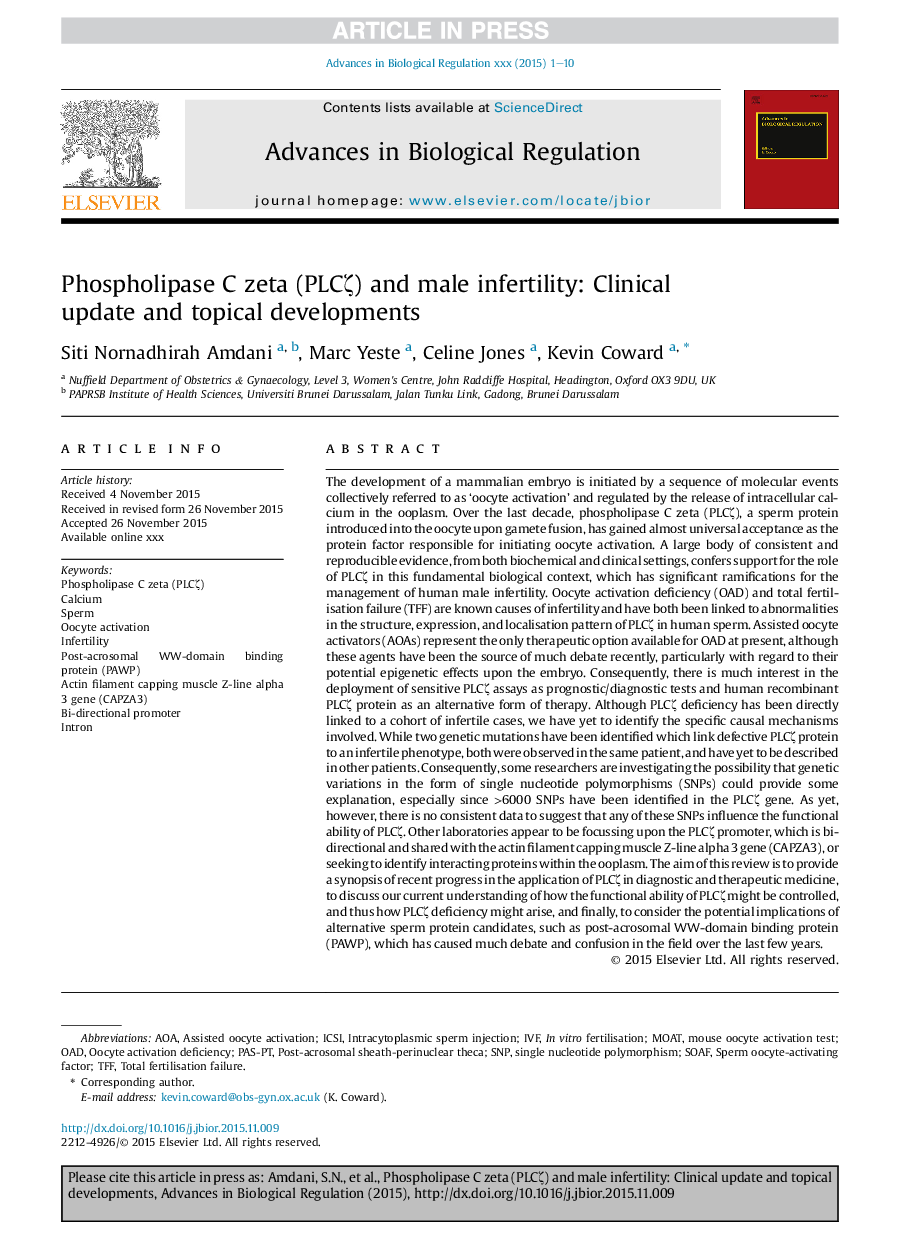| کد مقاله | کد نشریه | سال انتشار | مقاله انگلیسی | نسخه تمام متن |
|---|---|---|---|---|
| 8287867 | 1535870 | 2016 | 10 صفحه PDF | دانلود رایگان |
عنوان انگلیسی مقاله ISI
Phospholipase C zeta (PLCζ) and male infertility: Clinical update and topical developments
دانلود مقاله + سفارش ترجمه
دانلود مقاله ISI انگلیسی
رایگان برای ایرانیان
کلمات کلیدی
AOAOADIntronPhospholipase C zeta (PLCζ)In Vitro FertilisationTff - TFFSperm - اِسپِرمintracytoplasmic sperm injection - تزریق اسپرم داخلسیتوپلاسمیoocyte activation - فعال سازی اووسیتIVF - لقاح مصنوعی ICSI - میکرواینجکشنInfertility - ناباروریBi-directional promoter - پروموتر دو طرفهSingle nucleotide polymorphism - پلیمورفیسم تک نوکلئوتیدیSNP - چندریختی تک-نوکلئوتیدMoat - کرمCalcium - کلسیمassisted oocyte activation - کمک به فعال سازی تخمک
موضوعات مرتبط
علوم زیستی و بیوفناوری
بیوشیمی، ژنتیک و زیست شناسی مولکولی
زیست شیمی
پیش نمایش صفحه اول مقاله

چکیده انگلیسی
The development of a mammalian embryo is initiated by a sequence of molecular events collectively referred to as 'oocyte activation' and regulated by the release of intracellular calcium in the ooplasm. Over the last decade, phospholipase C zeta (PLCζ), a sperm protein introduced into the oocyte upon gamete fusion, has gained almost universal acceptance as the protein factor responsible for initiating oocyte activation. A large body of consistent and reproducible evidence, from both biochemical and clinical settings, confers support for the role of PLCζ in this fundamental biological context, which has significant ramifications for the management of human male infertility. Oocyte activation deficiency (OAD) and total fertilisation failure (TFF) are known causes of infertility and have both been linked to abnormalities in the structure, expression, and localisation pattern of PLCζ in human sperm. Assisted oocyte activators (AOAs) represent the only therapeutic option available for OAD at present, although these agents have been the source of much debate recently, particularly with regard to their potential epigenetic effects upon the embryo. Consequently, there is much interest in the deployment of sensitive PLCζ assays as prognostic/diagnostic tests and human recombinant PLCζ protein as an alternative form of therapy. Although PLCζ deficiency has been directly linked to a cohort of infertile cases, we have yet to identify the specific causal mechanisms involved. While two genetic mutations have been identified which link defective PLCζ protein to an infertile phenotype, both were observed in the same patient, and have yet to be described in other patients. Consequently, some researchers are investigating the possibility that genetic variations in the form of single nucleotide polymorphisms (SNPs) could provide some explanation, especially since >6000 SNPs have been identified in the PLCζ gene. As yet, however, there is no consistent data to suggest that any of these SNPs influence the functional ability of PLCζ. Other laboratories appear to be focussing upon the PLCζ promoter, which is bi-directional and shared with the actin filament capping muscle Z-line alpha 3 gene (CAPZA3), or seeking to identify interacting proteins within the ooplasm. The aim of this review is to provide a synopsis of recent progress in the application of PLCζ in diagnostic and therapeutic medicine, to discuss our current understanding of how the functional ability of PLCζ might be controlled, and thus how PLCζ deficiency might arise, and finally, to consider the potential implications of alternative sperm protein candidates, such as post-acrosomal WW-domain binding protein (PAWP), which has caused much debate and confusion in the field over the last few years.
ناشر
Database: Elsevier - ScienceDirect (ساینس دایرکت)
Journal: Advances in Biological Regulation - Volume 61, May 2016, Pages 58-67
Journal: Advances in Biological Regulation - Volume 61, May 2016, Pages 58-67
نویسندگان
Siti Nornadhirah Amdani, Marc Yeste, Celine Jones, Kevin Coward,